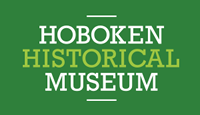Robert Forman – “Uncommon Threads”
January 26, 2014 - March 16, 2014

From a distance, an artwork by Robert Forman appears to be many paintings at once, layered in some mysterious way. Up close, the mystery deepens: Instead of paint, the surface is composed of many colored threads, laid downwith as much complex color theory as any Impressionist painting—or maybe more so, because Forman’s pictures have added dimensions of overlapping images and patterns.
For example, one piece, Engine Co. 5, depicts Forman’s home, an 1898 firehouse he bought at a city auction in 1982 and converted into a four-family residence. The building’s outline, its iconic red, arched door and its steep, green copper roof with dormer window are easy to pick out of the scene. However, interwoven with that image are ghostly images of the people past and present that have lived or worked in the building or in the neighborhood, including the artist’s family and neighbors, firefighters, and Frank Sinatra, whose father was captain there. Overlaying it all is a wave pattern crisscrossing the picture, alluding to the inundation from Superstorm Sandy that the artist and his family were rebuilding from while he worked on the artwork in 2013.
Engine Co. 5 is one of the highlights of the exhibit, “Uncommon Threads: String Pictures by Robert Forman,” which opened at the Hoboken Museum on January 26. The exhibit will remain on view until March 16, when the artist will give a talk about his work at 4 p.m.
Another picture in the exhibit depicts a squirrel on the grass in Church Square Park, surrounded by people lying on the grass, mowing the lawn, playing on the sea creatures in the water park. Once again, Forman incorporates a pattern in the threads to create a focal point around the squirrel, showing his dog’s view of the world, where everything else in the visual field fades out, except his crystal-clear target.
Click here to see a virtual gallery of the exhibit.
Forman’s website, robertforman.net, explains his process: “I begin with full-size drawings (cartoons). I trace the drawings and transfer them to Clayboard with carbon paper. In the case of multiple images, I use different colored carbon paper. I then glue yarn of different weights, colors and material to the Clayboard using Elmer’s Glue. I use cotton, silk, linen and rayon yarns. The finished picture is sealed with Fabric Guard. The final step is the frame, which I mill and build in my wood shop.”
Forman’s technique is self-taught; he began “painting with yarn” in high school, in Englewood, N.J., and continued while majoring in painting in college at Cooper Union in Manhattan. He kept the string pictures a secret until a professor asked the class about what they had worked on during vacation. His professor recognized his originality and encouraged him to keep at it. Like a lot of artists, he has supplemented his income as a fine art framer, and consequently, his frames often have complementary qualities to the work they contain.
In the 1990s, he came across some kindred spirits: The Huichol, a native tribe from northern Mexico, had a tradition of yarn paintings, using thicker yarns and beeswax. He earned a Fulbright scholarship in 1992 to study with them in the cities and villages of the western Sierra Madre mountains.
It can take a whole year to produce a large picture, and he works on two or three pictures a year. “It’s a slow process,” he says. “Instead of going faster, as I get more experience, I try more things and it can even take longer. I just don’t want to repeat the same thing—new ideas are what interest me.” His work has evolved from focusing on “retinal” effects—replicating the surface colors and texture, as in the picture, “Hoboken Station” to more layered compositions.
Forman’s work has been exhibited in the Newark, Brooklyn, Jersey City and Montclair Museums, and at the Francis M. Naumann Gallery on 57th Street. Visit his website, glueyarn.com, to learn more about his many exhibits and articles on his unique art.
The exhibit is supported by a block grant from the State/County Partnership program for the Arts, administered by the Hudson County Division of Cultural and Heritage Affairs.
